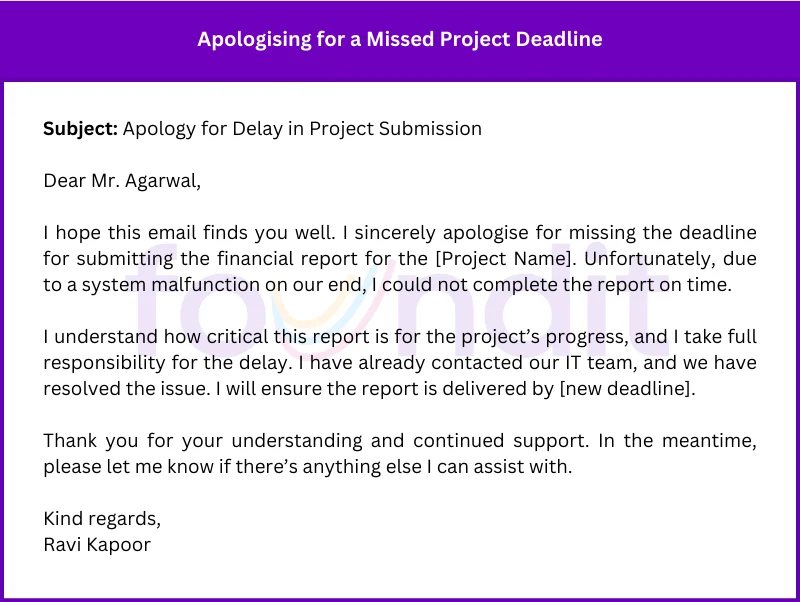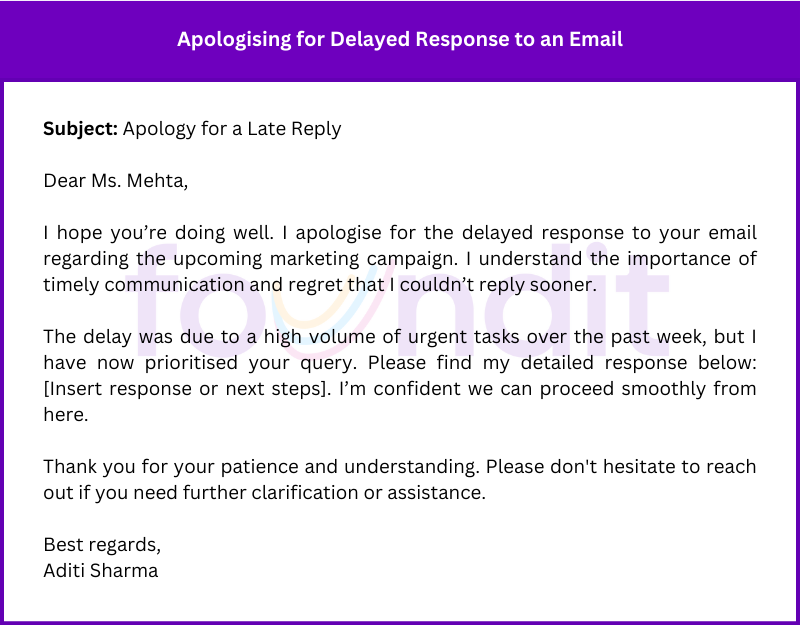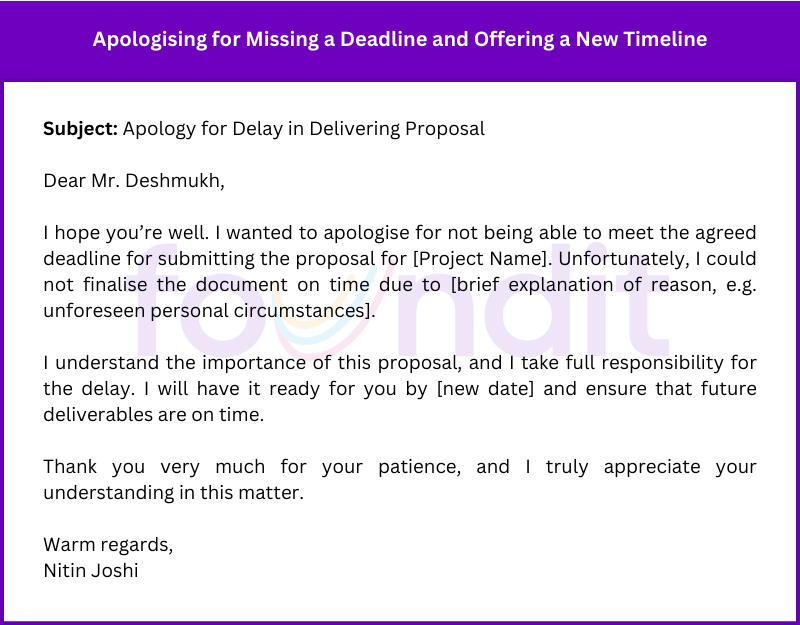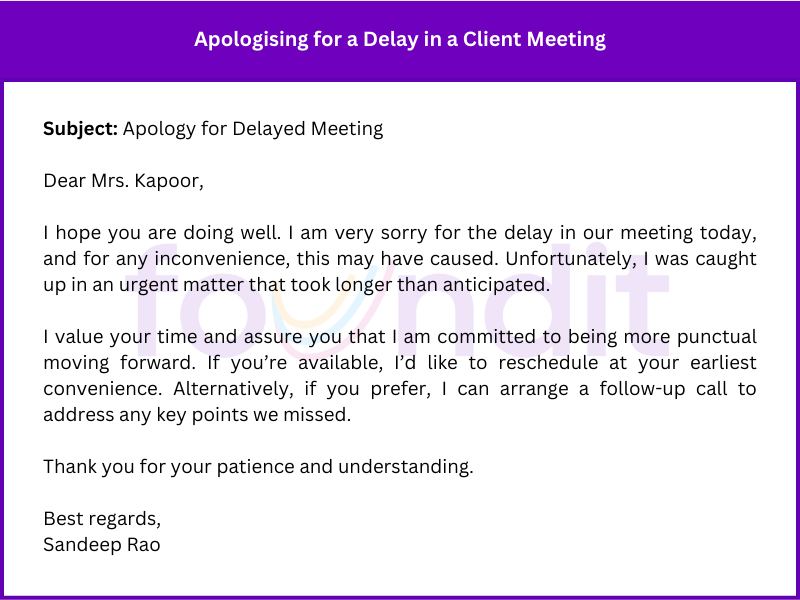We all experience delays in responding to emails or completing projects at some point. Sometimes, this might be unavoidable. But what makes a difference is how you apologise for delays. A sincere and well-written apology can salvage trust.
However, not addressing it properly might frustrate people and strain your professional relationships. Whether you are writing an email or apologising in person, how you approach the situation matters. This article will examine how to effectively apologise in email and in person to help you navigate these tricky situations professionally and gracefully.
1. Understanding the Context of the Delay
It is important to figure out the reason behind the delay before apologising. This foundational step will ensure your apology is tailored, appropriate, and well-received.
1.1 Identifying the Cause
Knowing the cause helps in offering a more relevant and meaningful apology. For instance, if it were a technical problem, admitting to poor time management would show that you’re working on the solution. Similarly, admitting to poor time management would display accountability.
1.2 Evaluating the Impact
Assessing the impact of the delay is crucial. Was it a minor inconvenience or a major disruption to the recipient’s work? Understanding the severity helps determine the tone and depth of your apology, with more significant delays requiring a more formal approach.
1.3 Determining the Appropriate Medium
Once the cause and impact are clear, decide how to apologise. A minor delay may be addressed via email, while more serious delays might require an in-person apology to show sincerity and commitment to resolving the issue.
2. Key Elements of an Effective Apology
Effective apologies for the delay require more than just saying “sorry.” To truly mend the situation and restore goodwill, your apology should cover several important aspects, each contributing to a clear and thoughtful response.
2.1 Sincerity
First and foremost, your apology should come across as sincere. Simply apologising without genuine emotion can seem dismissive or insincere. You want the recipient to understand that you truly regret the inconvenience caused.
2.2 Taking Responsibility
Avoid shifting blame onto external factors or other people. Acknowledge your role in the situation, whether the delay was caused by something within your control or due to external circumstances.
2.3 Providing an Explanation
Keep the explanation concise and relevant. For instance, if technical difficulties delayed a project, you could say, “We encountered an unexpected system failure, which delayed our progress.” It’s a lot better than providing a long-winded justification.
2.4 Offering Solutions
When apologising, it’s not enough to simply acknowledge the delay and its cause; you should also offer potential solutions or alternatives. This demonstrates your commitment to resolving the issue and minimising its impact on the recipient. For instance, if a project deadline has been missed, you could suggest a new timeline or offer additional support to compensate for the delay.
2.5 Assurance of Improvement
Lastly, assure the recipient that steps will be taken to prevent similar delays. This assurance can help restore trust and confidence in your ability to meet future expectations.
3. How to Write a Polite Email Apology for Delays
A well-structured email addresses the situation and reassures the recipient that steps are being taken to resolve the issue. Here, we’ll explore how to apologise for delays through an email:
3.1 Structure of a Polite Apology Email
A polite and professional apology email should be concise, clear, and considerate. The structure of your email is important to ensure that your message is respectful and solution-oriented. Below is a breakdown of each key element of an apology email.
Your subject line should be clear and professional, immediately informing the recipient of the purpose of your email. For example, “Apology for the Delay in [Task/Response].” This helps the recipient understand the content before opening the email.
- Opening line:
Start by acknowledging the delay right away. This sets the tone for the email and lets the recipient know you know the issue. An example might be, “I apologise for the delay in sending the report.”
- Body:
The body should include three key points:
- Explanation: Briefly explain the reason for the delay without going into unnecessary detail or making excuses. For example, “The delay was due to unexpected technical issues on our end.”
- Resolution: Describe the steps you are taking to resolve the delay. This shows your commitment to addressing the issue.
- Assurance: Reassure the recipient that you’re actively working to prevent similar delays in the future. For instance, “We’ve implemented new protocols to ensure this doesn’t happen again.”
Closing:
Conclude by thanking the recipient for their understanding and express your willingness to discuss any concerns. For example, “I appreciate your patience and understanding in this matter.”
People Are Also interested In: Learn How to Write Professional Email Greetings
3.2 Email Templates
Here are two email templates you can easily modify for different situations:
Template: Apologising for Missed Deadline
| Subject: Apology for Missed Deadline Dear [Recipient’s Name], I hope this email finds you well. I apologise for missing the deadline for [specific task or project]. Due to [brief explanation of the cause, e.g. unforeseen technical difficulties, personal reasons], I could not deliver the work on time. I understand the importance of meeting deadlines and take full responsibility for this delay. I am currently [steps you’re taking to resolve the issue], and I will ensure this does not happen again. Please let me know if there is anything I can do to make up for the delay. I appreciate your patience and understanding and am committed to immediately completing the task. I expect to submit it by [new deadline], and I’ll keep you updated. Thank you once again for your understanding. Sincerely, [Your Name] |
Template: Apologising for Late Communication or Response
| Subject: Apology for Delayed Response Dear [Recipient’s Name], I hope you’re doing well. I sincerely apologise for the delay in responding to your email regarding [mention the subject of the communication]. I understand that timely communication is crucial, and I deeply regret any inconvenience this may have caused. The delay was due to [brief explanation of the cause], but I have now addressed the matter and am fully committed to keeping communication more timely moving forward. Please find my response to your query below: [provide response or information requested]. I appreciate your patience and would happily discuss this further if needed. Thank you for your understanding. Kind regards, [Your Name] |
3.3 Email Examples
Below are a few practical email examples from different professional contexts:
Example: Apologising for a Missed Project Deadline
| Subject: Apology for Delay in Project Submission Dear Mr. Agarwal, I hope this email finds you well. I sincerely apologise for missing the deadline for submitting the financial report for the [Project Name]. Unfortunately, due to a system malfunction on our end, I could not complete the report on time. I understand how critical this report is for the project’s progress, and I take full responsibility for the delay. I have already contacted our IT team, and we have resolved the issue. I will ensure the report is delivered by [new deadline]. Thank you for your understanding and continued support. In the meantime, please let me know if there’s anything else I can assist with. Kind regards, Ravi Kapoor |

Example: Apologising for Delayed Response to an Email
| Subject: Apology for a Late Reply Dear Ms. Mehta, I hope you’re doing well. I apologise for the delayed response to your email regarding the upcoming marketing campaign. I understand the importance of timely communication and regret that I couldn’t reply sooner. The delay was due to a high volume of urgent tasks over the past week, but I have now prioritised your query. Please find my detailed response below: [Insert response or next steps]. I’m confident we can proceed smoothly from here. Thank you for your patience and understanding. Please don’t hesitate to reach out if you need further clarification or assistance. Best regards, Aditi Sharma |

Example: Apologising for Missing a Deadline and Offering a New Timeline
| Subject: Apology for Delay in Delivering Proposal Dear Mr. Deshmukh, I hope you’re well. I wanted to apologise for not being able to meet the agreed deadline for submitting the proposal for [Project Name]. Unfortunately, I could not finalise the document on time due to [brief explanation of reason, e.g. unforeseen personal circumstances]. I understand the importance of this proposal, and I take full responsibility for the delay. I will have it ready for you by [new date] and ensure that future deliverables are on time. Thank you very much for your patience, and I truly appreciate your understanding in this matter. Warm regards, Nitin Joshi |

Example: Apologising for a Delay in a Client Meeting
| Subject: Apology for Delayed Meeting Dear Mrs. Kapoor, I hope you are doing well. I am very sorry for the delay in our meeting today, and for any inconvenience, this may have caused. Unfortunately, I was caught up in an urgent matter that took longer than anticipated. I value your time and assure you that I am committed to being more punctual moving forward. If you’re available, I’d like to reschedule at your earliest convenience. Alternatively, if you prefer, I can arrange a follow-up call to address any key points we missed. Thank you for your patience and understanding. Best regards, Sandeep Rao |

3.4 Tips for Writing an Effective Apology Email
Crafting well-written apologies for the delayed response requires both empathy and professionalism. Here are some important tips to ensure your message is effective:
- Keeping the tone professional and empathetic: Send your sincere apologies for the inconvenience and show that you understand the impact of the delay. For instance, “I know this delay may have caused you inconvenience, and I truly appreciate your patience.”
- Avoiding defensive or dismissive language: It’s essential to take full responsibility for the delay and avoid language that deflects blame. For example, phrases like “It wasn’t my fault” or “I couldn’t help it” can be unprofessional and dismissive. Always focus on how you can resolve the issue.
- Including timelines for resolution or follow-ups: If applicable, provide a clear timeline for when the issue will be resolved or when you will follow up. This sets expectations and reassures the recipient that you are actively addressing the delay. For example, “I will send you the final report by the end of the day tomorrow.”
4. Delivering Professional In-Person Apologies
While apologising via email is effective, some situations demand a more personal approach. Delivering an in-person apology allows for deeper sincerity and connection, particularly when dealing with significant delays or misunderstandings. Here’s how to handle these situations with professionalism and empathy.
4.1 Preparing for the Apology
In-person apologies require careful preparation to communicate your message clearly and sincerely. Here are some important steps to help you apologise for delays in person:
- Ensure the setting is private and free from distractions, allowing both parties to focus on the conversation.
- Choose a time when the recipient will likely be calm and not under additional stress.
- Before speaking, take a moment to reflect on what you want to say.
4.2 Techniques for an Effective In-Person Apology
Delivering a heartfelt apology in person requires the right words and approach. Here are some techniques that will help you make your apology as effective as possible:
- Maintain eye contact and positive body language: Maintain a relaxed but steady gaze to show you are fully engaged in the conversation. Additionally, positive body language, such as an open posture and nodding, can reinforce your sincerity and show empathy.
- Be careful about your tone: Speak calmly and empathetically, avoiding a defensive or rushed tone. Express genuine regret and understanding of the impact your delay may have caused.
- Allowing the recipient to express their concerns: Listen attentively without interrupting, and avoid getting defensive. Acknowledging their concerns will show that you value their perspective and are willing to make amends.
4.3 Handling Emotional Reactions
Apologies in person can sometimes trigger emotional reactions, especially if the delay has caused significant inconvenience. It’s important to handle these situations with sensitivity:
- Responding to frustration or disappointment professionally: If the recipient expresses frustration or disappointment, remain calm and composed. Acknowledge their feelings by saying, “I can understand why you’re upset, and I regret causing you this inconvenience.”
- Reassuring the recipient without being defensive: It’s natural to want to defend yourself, but it’s important to avoid becoming defensive or making excuses. Instead, emphasise reassuring the recipient that you are committed to resolving the issue and preventing future delays. For example, “I realise this delay has caused problems, but I’m taking steps to ensure it doesn’t happen again.”
4.4 Example Scenarios
Here are two example scenarios to help you visualise how an in-person apology might play out in a professional context:
- Apologising to a colleague for project delays: “Hi Anjali, I wanted to speak to you about the delay in the project timeline. I realise this has affected your work, and I’m truly sorry for that. I take full responsibility, and I’ve already taken steps to adjust our process to ensure this doesn’t happen again.”
- Apologising to a client for missed deadlines: “Good morning, Mr. Shah. I want to sincerely apologise for missing the agreed-upon deadline for your report. I completely understand how this has impacted your planning. I’ve put additional resources in place to ensure this does not happen again, and I will have the final report ready by [new deadline].”
5. Addressing Specific Situations
Several delays may require a thoughtful and professional apology, each with nuances. Understanding the context can help you approach these situations with the appropriate tone and solution-oriented mindset.
5.1 Apologising for Business-Related Delays
Business delays can impact clients, colleagues, or suppliers. If there’s a delay in delivery or service, apologise promptly, explain the cause, and offer a revised timeline. For late payments or invoicing, clarify the reason and provide a solution with a clear resolution date to rebuild trust.
5.2 Apologising for Personal Delays
Personal delays, such as being late to meetings or responding to messages, should be acknowledged quickly. Apologise for any inconvenience, briefly explain the reason if necessary, and assure the recipient you’ll be more punctual or responsive.
5.3 Apologising for Team or Group Delays
If a team or group project is delayed, it’s important to apologise for the overall impact. Take collective responsibility as a team, explain any challenges faced, and outline how the group addresses the issue.
6. Cultural and Professional Sensitivities
Cultural expectations play a key role in how an apology is received. Some cultures prefer formal, elaborate apologies, while others favour a more direct, concise approach. It’s also essential to be aware of industry-specific nuances.
In formal industries such as finance or law, an apology should be more structured, professional, and less personal. In more informal industries like creative agencies, the tone can be more relaxed, but the sincerity of the apology should still be maintained.
People Also Read: 100 “Best Regards” Alternatives to Use When Closing an Email
7. Following Up After an Apology Email
Once you’ve delivered an apology, it’s important to sent follow up email to ensure the situation has been resolved and the relationship is on the mend.
- Ensuring Resolution: Follow through on your commitments to meet revised deadlines or deliver promised solutions. Meeting these new expectations shows that you are committed to resolving the issue.
- Checking for Feedback: It’s important to ensure that the recipient is satisfied with the outcome. Ask for feedback to confirm whether your actions have addressed the issue to their satisfaction.
- Building Trust: Demonstrate improvement through consistent actions. Building trust after a delay involves showing that you are dependable and that future delays will be minimised.
8. Mistakes to Avoid When Apologising for Delays
You should avoid the following common pitfalls to ensure your apology is effective:
- Stop Over-apologising: Excessive apologies can appear unprofessional and insincere. Focus on a brief, genuine apology without overemphasising the mistake.
- Avoid Blaming Others: Avoid deflecting blame onto others or external factors. Acknowledge your role in the delay and take responsibility for the situation.
- Refrain from Offering Insincere Apologies: A half-hearted apology can be worse than no apology at all. Be genuine in your remorse because a sincere apology can go a long way toward repairing a relationship and rebuilding trust.
Conclusion
Apologising effectively for delays is crucial in maintaining professionalism and trust in personal and professional relationships. Clear communication, taking responsibility, and offering solutions can go a long way in rebuilding trust and ensuring future success. By prioritising empathy, clarity, and accountability, you can turn a negative situation into an opportunity to strengthen your relationships. Remember, sincerity and professionalism are key to navigating delays with grace.
FAQs on Apologies for Delays
Q1: How do I apologise for the delay in an email?
A1: Start by acknowledging the delay immediately and express genuine regret. Briefly explain the reason for the delay, offer a solution or new timeline, and assure the recipient that you’re taking steps to avoid future issues.
Q2: When is it better to apologise in person rather than by email?
A2: In-person apologies are ideal for situations where the delay has had a significant impact, such as missed deadlines affecting important projects or client relationships. Face-to-face apologies allow for a more personal connection and show that you’re fully committed to resolving the issue.
Q3: How can I make my apology seem sincere?
A3: To make your apology sincere, take full responsibility for the delay and avoid offering excuses or deflecting blame. Acknowledge the recipient’s impact and express a genuine commitment to addressing the situation and preventing it from happening again.
Q4: What should I avoid in a professional apology?
A4: Avoid overapologising, as it can undermine your professionalism and make your apology seem insincere. Also, avoid blaming others or external factors and focus on taking accountability for your part in the delay.
Q5: How do I apologise in a culturally sensitive way?
A5: Be aware of cultural differences in apology norms. Some cultures prefer formal and elaborate apologies, while others may favour more direct and concise expressions. Tailor your tone, body language, and wording to align with the recipient’s cultural expectations.
You May Also Like:
- How To Write An Apology Letter: Tips, Format and Samples
- How to Write “Please Disregard My Previous Email”




